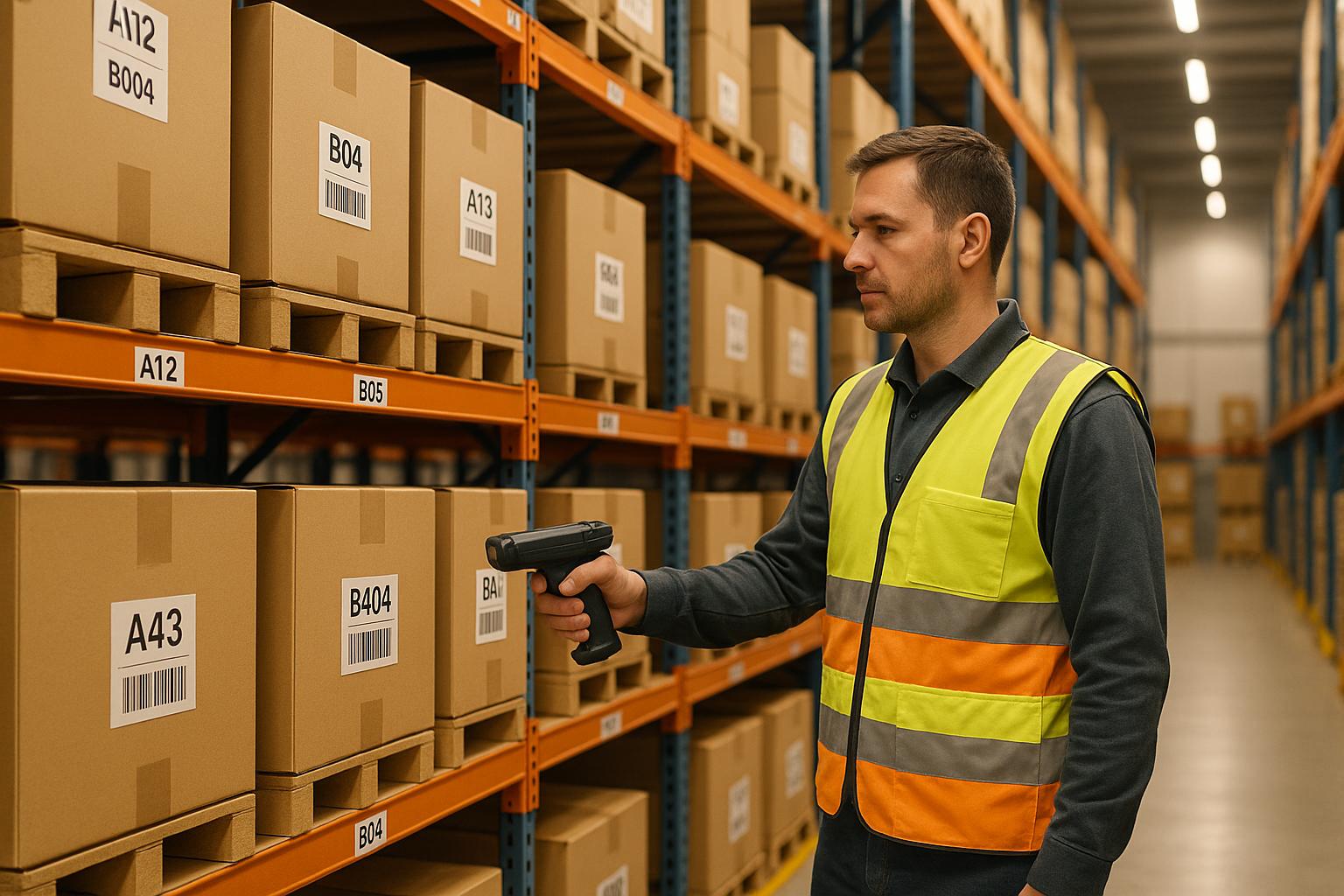Best Practices for Inventory Control in 3PL Warehouses

Managing inventory in 3PL warehouses is critical for reducing costs and meeting customer demands. Here's what you need to know:
- Inventory control ensures stock levels are optimized, minimizing costs and preventing stockouts that can drive customers to competitors.
- 3PL providers manage storage, shipping, and tracking for multiple clients, offering scalability and faster fulfillment.
- Effective inventory management can reduce logistics costs by up to 52% and cut inventory expenses by 6%.
- Key methods include Fixed Order Quantity, Vendor-Managed Inventory (VMI), and setting safety stock and reorder points.
- Regular physical inventory checks, efficient product placement, and data analytics help prevent shrinkage and improve accuracy.
- Technology like Warehouse Management Systems (WMS) provides real-time inventory visibility, automates processes, and integrates with client systems for better efficiency.
How Inventory Management, Tariffs, and Returns Are Transforming E-Commerce, Jeff Anaraj of Cybership

Main Inventory Control Methods for 3PL Warehouses
Managing inventory in 3PL warehouses demands precision, especially when dealing with diverse stock and fluctuating demand. The right method depends on factors like order volume, demand patterns, and operational goals. These strategies create a solid base for improving accuracy and minimizing shrinkage, which will be covered in the next section.
Fixed Order Quantity and Period Ordering Systems
To tackle inventory challenges faced by e-commerce brands, 3PL warehouses often rely on structured ordering systems. Two common methods are Fixed Order Quantity (Q) and Fixed Order Period (P) systems:
- Fixed Order Quantity (Q): This system triggers a set quantity reorder whenever inventory hits a specific threshold, calculated using the EOQ (Economic Order Quantity) formula. It balances ordering and holding costs but requires constant inventory monitoring.
- Fixed Order Period (P): Orders are placed at regular intervals, with quantities based on current needs. Since inventory is checked only during scheduled reviews, this system typically requires higher safety stock.
Here’s a quick comparison of these systems:
-
System Feature
-
Fixed Order Quantity (Q)
- Order Amount: Fixed quantity each time
- Order Timing: When reorder point is reached
- Inventory Monitoring: Continuous review
- Safety Stock: Lower requirements
-
Fixed Order Period (P)
- Order Amount: Varies based on current needs
- Order Timing: At set time intervals
- Inventory Monitoring: Periodic review
- Safety Stock: Higher requirements
-
Fixed Order Quantity (Q)
Many 3PL warehouses combine these methods, using both continuous monitoring and periodic reviews to strike the right balance of efficiency and safety stock levels.
Vendor-Managed Inventory (VMI)
Vendor-Managed Inventory (VMI) takes a collaborative approach, where suppliers actively manage and replenish stock at the 3PL warehouse. By sharing real-time data, suppliers can align inventory levels with actual market demand. Key elements of VMI include:
- Formal agreements between suppliers and warehouses
- Real-time data sharing for accurate replenishment
- Clear communication to streamline operations
This strategy simplifies inventory management, reduces carrying costs, and improves production scheduling - a huge advantage for e-commerce businesses dealing with high transaction volumes and varied product ranges. However, its success hinges on strong collaboration, clear performance metrics, and secure data sharing.
Minimum Stock and Safety Stock Strategies
Setting proper minimum and safety stock levels is essential for avoiding stockouts while controlling costs. Here’s how they work:
- Safety Stock: This is the extra inventory reserved for unexpected demand spikes or supply delays. It ensures operations run smoothly even during disruptions.
- Reorder Point: This signals when stock levels dip low enough to require replenishment.
The formulas for calculating these are:
-
Safety Stock:
(Max daily usage × max lead time) – (average daily usage × average lead time) -
Reorder Point:
(Average daily usage × average lead time) + safety stock
To maintain optimal levels, businesses should regularly update demand forecasts and use automated tracking tools. Many e-commerce companies aim for a service level between 95% and 99%, balancing customer satisfaction with inventory costs. Seasonal changes and demand shifts also require frequent reviews to keep stock levels aligned with market needs.
How to Improve Inventory Accuracy and Prevent Shrinkage
Managing inventory effectively in 3PL warehouses is essential for keeping operations smooth and minimizing shrinkage. Shrinkage - caused by theft, damage, or mistakes - can lead to significant financial losses. Since inventory often represents the largest asset on a company's balance sheet, maintaining accurate records is crucial for both profitability and keeping customers happy. By adopting specific strategies, warehouses can cut down on losses and improve efficiency.
Regular Physical Inventory Checks
Physical inventory counts are the backbone of accurate record-keeping. The key is choosing the right method and implementing it in a way that minimizes disruptions while maintaining precision. Most modern 3PL warehouses rely on one of four common methods:
-
Physical Inventory Method
-
Manual Completion
- Description: Uses paper forms to record inventory
- Pros: Low material cost
- Cons: High chance of errors
-
Electronic Counting
- Description: Utilizes tools like scanners, RFID, or barcodes
- Pros: Reduces errors significantly
- Cons: Requires extra time and resources
-
Cycle Counting
- Description: Rotating sections of inventory are counted regularly
- Pros: Limits operational disruptions
- Cons: May not provide full inventory coverage as often
-
Full Inventory
- Description: All stock is counted at once, often using temporary staff
- Pros: Offers a comprehensive snapshot
- Cons: Labor-intensive and may require halting operations
-
Manual Completion
To ensure smooth counts, plan them in advance, assign bin locations, remove unsaleable items, and ship out open orders beforehand. Using a blind count process - where counters don’t know the system’s recorded quantities - can increase accuracy further. Follow-up quality checks and quick IT support for system issues are also vital for reliable records.
Once accurate counts are in place, refining product placement and picking methods can further reduce shrinkage.
Better Product Placement and Picking Methods
Strategic product placement and efficient picking processes not only reduce shrinkage but also make warehouse operations more effective. Top-tier 3PL providers often maintain error rates below 0.5%, leading to fewer returns, lower costs, and happier customers.
An optimized warehouse layout starts with assigning products to ideal slot locations, which minimizes errors and ensures proper stock rotation. Clear and consistent labeling further helps in tracking inventory accurately. Placing items in their designated spots immediately after receipt prevents misplaced goods, while additional checks during receiving catch errors early.
The choice of picking method also plays a big role in efficiency and accuracy. For warehouses handling over 100 orders daily, batch picking can improve productivity by 30–40% compared to picking items one by one. Wave picking is great for meeting tight shipping deadlines, while zone picking works well in large facilities with diverse inventory. Using digital verification during picking can cut errors by up to 67% compared to paper-based methods.
Real-world examples highlight the benefits of these practices. In 2024, Red Stag Fulfillment achieved an impressive 99.993% accuracy rate - equivalent to just 0.007% shrinkage - through investments in automation, RFID tracking, and strict quality controls. Similarly, a skincare brand processing 1,500 orders monthly improved accuracy from 96% to 99.7% and reduced its cost per order from $5.80 to $3.00 after partnering with a specialized 3PL.
Using Data Analytics for Loss Prevention
Once accurate inventory counts and efficient handling are in place, data analytics can take loss prevention to the next level. By identifying patterns and trends, warehouses can detect shrinkage sources before they become major issues.
Real-time inventory tracking is the foundation of effective analytics, allowing managers to quickly spot discrepancies caused by theft, damage, or errors. Regular counts and surprise audits also help catch anomalies early. Centralizing inventory data provides a unified view of operations, making decision-making more accurate and ensuring that audits align with up-to-date records.
AI-powered tools add even more value. For example, AI-driven forecasting can cut inventory costs by 35%, improve service levels by 65%, and reduce disruptions by 30%. Categorizing inventory based on factors like value, cost, and demand helps managers focus on the most critical items.
Leading companies showcase how these technologies make a difference. UPS’s AI-powered ORION system, for instance, saves the company 100 million miles annually and cuts fuel consumption by 10 million gallons each year. Similarly, DHL’s use of collaborative robots has decreased manual sorting time by 25%, lowering labor costs and reducing errors.
"ShipBob is our source of truth for shipping data. I also love the analytics tools, and so do my accountants." - Courtney Lee, Founder of Prymal
sbb-itb-eafa320
Using Technology for Inventory Control
Technology is reshaping how 3PL providers manage inventory, replacing outdated manual processes with automation. Back in 2018, a survey revealed that 87% of warehouses were still using manual methods during the receiving process. By automating operations, advanced technology not only speeds things up but also provides real-time insights, creating a more efficient and transparent system.
How Warehouse Management Systems (WMS) Help
Warehouse Management Systems (WMS) are at the core of 3PL operations, taking charge of everything from receiving inventory to final shipping. These systems offer real-time updates on inventory levels, locations, and movements, eliminating guesswork and reducing costly mistakes. For example, order picking - one of the most expensive tasks in warehousing - accounts for 55% of total costs. By automating processes like picking, packing, and shipping, WMS reduces manual errors and speeds up fulfillment.
WMS platforms also keep inventory records accurate and send alerts when stock levels dip too low. This proactive feature helps avoid overstocking or running out of products, ensuring smoother workflows. Beyond that, modern WMS systems provide detailed analytics, helping managers monitor KPIs and make informed decisions about warehouse layout, staffing, and more. By analyzing factors like product dimensions, turnover rates, and picking trends, these systems can even optimize space usage, often increasing capacity without the need for physical expansion. It’s no wonder that 26% of WMS users report saving significant time, which directly translates to cost savings and better service.
Benefits of Real-Time Inventory Visibility
Real-time inventory visibility has transformed warehouse operations and client relationships. Unlike older systems that update periodically, today’s WMS platforms offer live updates as items move through the warehouse, giving an instant snapshot of inventory status. This real-time data allows for smarter decisions about restocking and storage.
Transparency also strengthens partnerships with clients. For example, e-commerce brands with access to real-time inventory data can better plan promotions, product launches, and customer communication. Accurate, up-to-date information improves financial reporting and forecasting, which is especially crucial during peak seasons when inventory levels fluctuate rapidly. Additionally, the ability to track inventory as it moves through the system helps prevent losses by flagging discrepancies early. This level of transparency ensures all operations stay synchronized and efficient.
Integration with Client Systems
Seamless integration between a 3PL’s WMS and client systems is key to supporting e-commerce growth. For instance, a WMS must work hand-in-hand with transportation management systems (TMS), enterprise resource planning (ERP) platforms, and e-commerce tools. This eliminates data silos, reduces manual input, and ensures everyone involved has real-time access to inventory and order details.
JIT Transportation takes this a step further by integrating ERP systems with additional services like pick-and-pack, kitting and assembly, and vendor-managed inventory. This approach ensures every activity is tracked and coordinated efficiently.
When choosing integration solutions, 3PL providers should look for systems that allow customizable workflows to meet specific business needs. A well-integrated system not only improves speed and reliability but also supports scalability as operations expand.
Looking ahead, the future of WMS includes exciting innovations like AI-driven predictive analytics, automation and robotics, blockchain for supply chain transparency, and sustainability-focused initiatives. These advancements will further refine forecasting, improve inventory management, and enhance labor efficiency.
Custom Solutions and Value-Added Services
Today's 3PL providers go beyond basic logistics, offering specialized services that improve inventory management. By combining advanced inventory techniques with tailored solutions, they tackle unique challenges while boosting accuracy and efficiency.
How Value-Added Services Improve Inventory Management
Services like kitting, labeling, and personalization play a big role in improving inventory accuracy and efficiency. When 3PL providers handle these tasks directly, they minimize errors that can occur when products pass through multiple hands.
Take kitting and assembly, for instance. By bundling components into pre-assembled kits, businesses can track them as single SKUs rather than managing each part separately. This simplifies warehouse operations and reduces picking errors during fulfillment. Similarly, when 3PLs take care of product testing or upgrades on-site, they can update inventory and quality records in real time, aligning with specific brand requirements.
Returns management is another area where value-added services shine. Efficient in-house processes for inspecting, refurbishing, and restocking returned items are essential. With over $200 billion worth of merchandise returned in 2021 - around 20% of total online sales - streamlined returns are critical for maintaining accurate inventory.
Scalable Solutions for High-Growth E-Commerce Brands
Fast-growing e-commerce businesses need adaptable solutions to handle rising order volumes without compromising service quality.
Modern e-commerce operations require 3PL providers equipped with advanced systems for B2C distribution, including tools for Amazon shipping and direct-to-consumer fulfillment. Considering that 25% of customers return 5-15% of their purchases, these brands also need partners skilled in managing reverse logistics while keeping inventory precise.
For example, Willow, a consumer medical device company, prioritized 3PL providers that offered direct-to-consumer fulfillment, Amazon integration, and services like product rework and late-stage differentiation.
JIT Transportation is a standout example, addressing scalability with its nationwide network and cutting-edge technology. Their approach allows businesses to smoothly expand from single-channel operations to multi-channel fulfillment, covering retail, e-commerce, and marketplace platforms.
Transportation is also a key factor in scalable inventory management. Research shows that expertise in transportation and freight is a major reason businesses choose to partner with 3PL providers. By integrating inventory control with transportation planning, companies can optimize stock levels based on shipping schedules.
The best 3PL partners combine innovation, flexibility, and a strong track record of reliability. This enables businesses to focus on their core strengths while ensuring 3PL operations grow seamlessly alongside their needs.
Conclusion: Improving Inventory Control in 3PL Warehouses
Effective inventory control is the backbone of success for 3PL warehouses, driving down costs while ensuring smooth operations. Companies utilizing 3PL services report impressive results, including up to a 52% reduction in logistics costs and a 26% boost in customer service performance. It's no surprise that 86% of Fortune 500 companies rely on these solutions to stay ahead in the game.
The combination of time-tested methods, cutting-edge technology, and strategic partnerships creates a winning formula for operational efficiency and profitability. Techniques like fixed order quantity systems, vendor-managed inventory, and safety stock strategies provide a solid operational framework. Meanwhile, tools like warehouse management systems (WMS) and real-time tracking bring the precision needed to meet the demands of today’s fast-moving e-commerce world.
Advanced technologies such as RFID and AI-powered analytics are game-changers, offering real-time inventory visibility, quicker decision-making, and reduced shrinkage. These innovations aren't just theoretical - they’re delivering measurable results in real-world applications.
Take BAKblade, for example. After partnering with a 3PL provider, the company saw a staggering 291% sales growth over three years. Founder Matt Dryfhout emphasized the importance of trusting experts:
"We were not set up to fulfill thousands of orders or prepared to manage the complexities of shipping. It just made a lot more sense for us to put our trust in somebody we knew that was number one in their game and would continue to get better and better."
– Matt Dryfhout, BAKblade founder and CEO
Similarly, Allbirds optimized their fulfillment processes, cutting costs and shipping times while enhancing customer satisfaction - all through strategic 3PL partnerships.
Another standout example is JIT Transportation, which combines a nationwide network, advanced tech, and scalable infrastructure to meet the evolving needs of its clients. Their integrated solutions illustrate how modern 3PL providers act as true partners, delivering the technological and operational advancements discussed throughout this guide.
Strong inventory control doesn’t just improve efficiency - it drives customer satisfaction and profitability. With global e-commerce sales expected to hit around $6 trillion in 2024, brands looking to scale must embrace comprehensive 3PL solutions to stay competitive in this high-stakes marketplace.
FAQs
What are the benefits of using a Warehouse Management System (WMS) for inventory control in 3PL warehouses?
Using a Warehouse Management System (WMS) in 3PL warehouses can transform daily operations by boosting efficiency and simplifying complex tasks. By automating processes such as receiving, picking, and shipping, a WMS helps reduce mistakes, speeds up order handling, and increases overall productivity.
It also improves inventory accuracy and visibility, allowing businesses to monitor stock levels in real time, avoid overstock or shortages, and make better use of available storage space. These upgrades not only lower operational expenses but also enable faster order fulfillment and improve customer satisfaction - key factors for thriving in the competitive logistics world.
What is Vendor-Managed Inventory (VMI), and how can it benefit e-commerce businesses compared to traditional inventory management?
Vendor-Managed Inventory (VMI) is a system where suppliers take charge of tracking and restocking inventory based on shared sales and demand data. Unlike the traditional approach, where businesses manage their own stock levels, VMI shifts that responsibility to the supplier. This reduces the workload for companies while ensuring inventory is handled efficiently.
For e-commerce brands, this setup comes with some key benefits: more accurate inventory management, reduced operational expenses, and improved demand forecasting. By keeping products in stock and ready to ship, VMI helps prevent stockouts, speeds up order fulfillment, and boosts customer satisfaction. It's a practical way to simplify supply chain operations and keep things running smoothly.
How do safety stock and reorder point strategies help prevent stockouts and manage costs in 3PL warehouses?
Safety stock acts as a buffer, ensuring products are available even when demand unexpectedly surges or supply chain hiccups occur. It’s like having a safety net to keep things running smoothly during unpredictable moments. Meanwhile, reorder point strategies focus on pinpointing the perfect moment to restock inventory, helping businesses avoid the headaches of overstocking or running out of stock.
In 3PL warehouses, these approaches are key to finding the sweet spot between keeping costs under control and delivering reliable service. By maintaining the right inventory levels, businesses can dodge expensive last-minute shipments, cut down on unnecessary storage costs, and keep operations flowing seamlessly to meet customer needs.
Related posts
Related Articles

How Scalable Supply Chains Support E-commerce Growth

Ultimate Guide to Blockchain in Logistics

